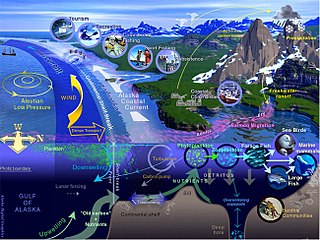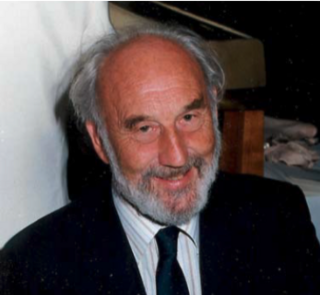
Caenorhabditis elegans is a free-living transparent nematode about 1 mm in length that lives in temperate soil environments. It is the type species of its genus. The name is a blend of the Greek caeno- (recent), rhabditis (rod-like) and Latin elegans (elegant). In 1900, Maupas initially named it Rhabditides elegans. Osche placed it in the subgenus Caenorhabditis in 1952, and in 1955, Dougherty raised Caenorhabditis to the status of genus.

Sydney Brenner was a South African biologist. In 2002, he shared the Nobel Prize in Physiology or Medicine with H. Robert Horvitz and Sir John E. Sulston. Brenner made significant contributions to work on the genetic code, and other areas of molecular biology while working in the Medical Research Council (MRC) Laboratory of Molecular Biology in Cambridge, England. He established the roundworm Caenorhabditis elegans as a model organism for the investigation of developmental biology, and founded the Molecular Sciences Institute in Berkeley, California, United States.

Marine life, sea life, or ocean life is the plants, animals, and other organisms that live in the salt water of seas or oceans, or the brackish water of coastal estuaries. At a fundamental level, marine life affects the nature of the planet. Marine organisms, mostly microorganisms, produce oxygen and sequester carbon. Marine life in part shape and protect shorelines, and some marine organisms even help create new land.

Caenorhabditis is a genus of nematodes which live in bacteria-rich environments like compost piles, decaying dead animals and rotting fruit. The name comes from Greek: caeno- ; rhabditis = rod-like. In 1900, Maupas initially named the species Rhabditis elegans, Osche placed it in the subgenus Caenorhabditis in 1952, and in 1955, Dougherty raised Caenorhabditis to the status of genus.
Tullis Onstott was a professor of geosciences at Princeton University who has done research into endolithic life deep under the Earth's surface. In 2011 he co-discovered Halicephalobus mephisto, a nematode worm living 0.9–3.6 km (0.56–2.24 mi) under the ground, the deepest multicellular organism known to science. He won a LExEN Award for his work "A Window Into the Extreme Environment of Deep Subsurface Microbial Communities: Witwatersrand Deep Microbiology Project". In 2007, Onstott was listed among Time Magazine's 100 most influential people in the world.

Marine invertebrates are the invertebrates that live in marine habitats. Invertebrate is a blanket term that includes all animals apart from the vertebrate members of the chordate phylum. Invertebrates lack a vertebral column, and some have evolved a shell or a hard exoskeleton. As on land and in the air, marine invertebrates have a large variety of body plans, and have been categorised into over 30 phyla. They make up most of the macroscopic life in the oceans.

The nematodesroundworms or eelworms, constitute the phylum Nematoda. They are a diverse animal phylum inhabiting a broad range of environments. Most species are free-living, feeding on microorganisms, but there are many that are parasitic. The parasitic worms (helminths) are the cause of soil-transmitted helminthiases.
Halicephalobus mephisto is a species of nematode, among a number of other roundworms, discovered by geoscientists Gaetan Borgonie and Tullis Onstott in 2011. It was detected in ore recovered from deep rock fracture water in several gold mines in South Africa 0.9 km (0.56 mi), 1.3 km (0.81 mi), and 3.6 km (2.2 mi) under the surface of the Earth. Onstott said that "it scared the life out of me when I first saw them moving", and explained that "they look like black little swirly things". The finding is significant because no other multicellular organism had ever been detected farther than 2 km (1.2 mi) below the Earth's surface.
Caenorhabditis tropicalis is a species of Caenorhabditis nematodes, belonging to the Elegans super-group and Elegans group within the genus. It is a close relative of C. wallacei.C. tropicalis is collected frequently in tropical South America, Caribbean islands, and various islands in the Indian and Pacific Oceans from rotting fruit, flowers and stems. C. tropicalis was referred to as “C. sp. 11” prior to 2014.
Caenorhabditis monodelphis is a species of nematodes in the genus Caenorhabditis. It was first collected by J. Raschka in Berlin, Germany in 2001. A second isolate was collected from Norway. It is a free-living species found in galleries inside of the fungus Ganoderma applanatum (Polyporaceae) which grew on the stump of a tree a few centimeters above ground. It is phoretic on beetles of the species Cis castaneus.
Diploscapter is a genus of nematodes in the family Rhabditidae.
Oscheius is a genus of nematode.
Protorhabditis is a genus of nematodes in the family Rhabditidae.
Myolaimidae is a family of nematodes in the order Rhabditida. It consists of two genera, Myolaimus and Deleyia.
István Andrássy was a Hungarian nematologist. Starting with his first publication in 1952 on the nematode fauna of Mount Bükk, over his dissertation in 1973 on the evolution of nematodes to his last days he was a very prolific scientist, publishing more than 200 manuscripts, chapters and books on the class of Nematoda. He described 530 taxa of nematodes and at least 60 nematode taxa are named after him, which shows the huge respect he had in the nematologists world.
Mononchoides is a genus of nematodes belonging to the family Diplogastridae.
Halicephalobus is a genus of nematodes belonging to the family Panagrolaimidae.

Warwick Llewellyn Nicholas (1926–2010) was an Australian zoologist known as a pioneer in the field of nematology. He was a foundational member of the Australian Society for Parasitology (ASP) and in 1964, he organised the first ASP meeting. He became President of the Society in 1978, before being an elected Fellow from 1979.







